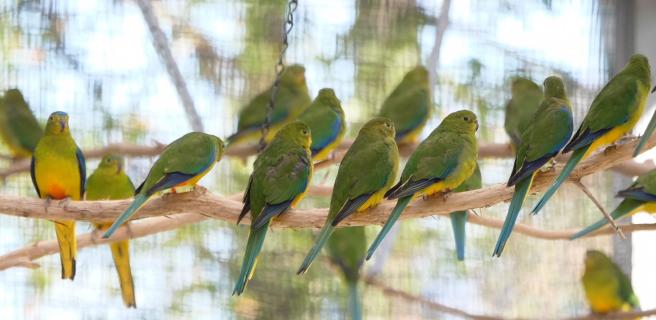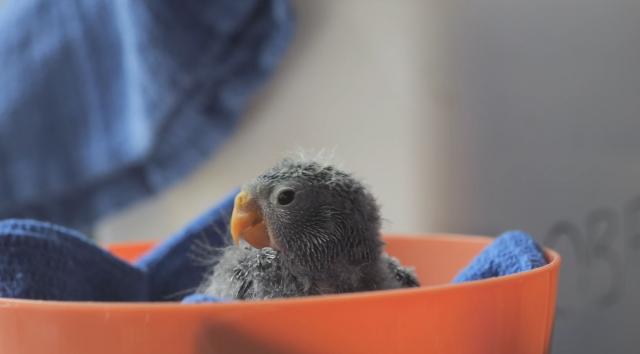Forty-one of the rarest and most mysterious animals in the world are taking flight at Healesville Sanctuary, marking a significant conservation triumph.
The critically endangered Orange-bellied parrot chicks were born in November and December and are being closely monitored in a dedicated threatened species hub.
Healesville Sanctuary threatened species bird keeper Veronica Peric said the chicks recently underwent health checks and passed with flying colours, although their grey feathers are yet to change to the distinctive green, yellow, blue and orange plumage that distinguishes the species.
“At three-weeks-old we give the chicks an examination that includes checking their weight and providing them uniquely coloured leg bands for identification,” she said.
“Four to five weeks prior to selection for release to the wild, the parrots receive a full veterinary health check that includes checking their body condition, feather condition, blood testing and DNA tests to determine sex.”
The Orange-bellied parrot is an Australian native species and one of only three migratory parrots on the entire planet.
Each year, the species fascinatingly journeys over the rough ocean of the Bass Strait from Tasmania to the Australian mainland and back again.
However, conservationists currently only know where about 10 per cent of Orange-bellied parrots go when they are not at their Tasmanian breeding locations and one of the key problems is the low survival rate of the species during this period.
Zoos Victoria is part of a national breeding program and is working with the Victorian Department of Energy, Environment and Climate Action and other Orange-bellied parrot recovery partners to learn about the species’ movements in the wild.
Healesville Sanctuary and Werribee Open Range Zoo have established dedicated, Orange-bellied parrot facilities that help to maintain a genetically viable insurance population and each year release birds to supplement wild populations.
Today, there are more than 500 birds in this national insurance population.
“Healesville Sanctuary is the only place with nest box cameras on the Orange-bellied parrots which allow us to monitor the health and parenting of the chicks 24/7 with less disturbance,” Ms Peric said.
The Orange-bellied measures little more than 20 centimeters and weighs a mere 50 grams when fully grown.
It spends summer breeding in Tasmania and autumn and winter feeding in Victoria and South Australia, where they are exclusively seen in coastal and sub-coastal areas inhabiting saltmarshes, littoral heathlands and low scrublands.
The species was historically observed in flocks numbering up to hundreds along Australia’s southeastern coastline.
However, the population declined dramatically throughout the 19th century and until as recently as 2016, where only 17 wild parrots returned to the one known species’ breeding location in Melaleuca in south-west Tasmania.
An escalation of conservation efforts by The Orange-bellied parrot Recovery Team, a group of representatives from national conservation organisations including Zoos Victoria and state governments, is generating renewed hope for the species’ survival.
This year, 81 birds returned to Tasmania; a record for the species.
Visitors to Healesville Sanctuary can see Orange-bellied parrots in the Fighting Extinction aviary located on the main track.
The Victorian Government’s Icon Species Program plays a key role in the ongoing conservation efforts of Victoria’s threatened species.
Since 2016, the Icon Species Program has provided more than $4.6 million to support conservation projects for 22 of Victoria’s threatened species including the Orange-bellied Parrot.









